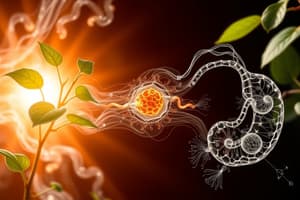Podcast
Questions and Answers
What is the primary source of energy for plants resulting from photosynthesis?
What is the primary source of energy for plants resulting from photosynthesis?
- Oxygen
- Carbon Dioxide
- Glucose (correct)
- Water
Which gas is released as a waste product during photosynthesis?
Which gas is released as a waste product during photosynthesis?
- Oxygen (correct)
- Carbon Dioxide
- Nitrogen
- Hydrogen
What is the energy source that drives the process of photosynthesis?
What is the energy source that drives the process of photosynthesis?
- Water
- Sunlight (correct)
- Glucose
- Carbon Dioxide
What is split into hydrogen ions (H+) and electrons during the light-dependent reactions of photosynthesis?
What is split into hydrogen ions (H+) and electrons during the light-dependent reactions of photosynthesis?
In cellular respiration, what molecule is used for the synthesis of energy?
In cellular respiration, what molecule is used for the synthesis of energy?
What is a common molecule used in both photosynthesis and cellular respiration as a product and reactant respectively?
What is a common molecule used in both photosynthesis and cellular respiration as a product and reactant respectively?
What is the primary energy currency of the cell?
What is the primary energy currency of the cell?
Which gas is produced as a waste product during cellular respiration?
Which gas is produced as a waste product during cellular respiration?
What is the source of energy for cellular respiration?
What is the source of energy for cellular respiration?
Where does photosynthesis occur in plant cells?
Where does photosynthesis occur in plant cells?
Which process breaks down glucose to produce ATP?
Which process breaks down glucose to produce ATP?
What is the anabolic process that synthesizes glucose from carbon dioxide and water?
What is the anabolic process that synthesizes glucose from carbon dioxide and water?
Study Notes
Photosynthesis and Cellular Respiration
Photosynthesis and cellular respiration are fundamental biological processes that are essential for the existence of life on Earth. Both processes involve the conversion of energy and the use of the same molecules: oxygen (O2), carbon dioxide (CO2), water (H2O), glucose (C6H12O6), and adenosine triphosphate (ATP). In this article, we will discuss the products and reactants of photosynthesis and cellular respiration, and compare the two processes.
Products of Photosynthesis
Photosynthesis is the process by which plants and some bacteria convert sunlight, water, and carbon dioxide into glucose and oxygen. The products of photosynthesis are as follows:
- Glucose: A type of sugar that serves as the primary source of energy for plants.
- Oxygen: A gas that is released as a waste product during photosynthesis. In the case of plants, oxygen is essential for the survival of animals and humans.
Reactants of Photosynthesis
The reactants of photosynthesis are the raw materials that are required for the process to occur. The reactants include:
- Sunlight: The energy source that drives the process of photosynthesis.
- Water: Molecules of water are split into hydrogen ions (H+) and electrons during the light-dependent reactions of photosynthesis.
- Carbon Dioxide: A gas that is taken in by plants from the atmosphere and used as a source of carbon for the synthesis of glucose.
Products of Cellular Respiration
Cellular respiration is the process by which cells convert glucose and oxygen into ATP, carbon dioxide, water, and heat. The products of cellular respiration are:
- ATP: Adenosine triphosphate (ATP) is the primary energy currency of the cell. It is used to power various cellular processes.
- Carbon Dioxide: A gas that is produced as a waste product during cellular respiration.
- Water: A liquid that is produced as a waste product during cellular respiration.
Reactants of Cellular Respiration
The reactants of cellular respiration are the substances that are required for the process to occur. The reactants include:
- Glucose: A sugar that is used as a source of energy for cellular respiration.
- Oxygen: A gas that is required for the process of cellular respiration to occur. Oxygen is used in the electron transport chain to produce ATP.
Comparison of Photosynthesis and Cellular Respiration
Both photosynthesis and cellular respiration are interconnected processes that play a crucial role in the survival of living organisms. While photosynthesis is an anabolic process that synthesizes glucose from carbon dioxide and water, cellular respiration is a catabolic process that breaks down glucose to produce ATP. Photosynthesis occurs in the chloroplasts of plant cells, while cellular respiration takes place in the mitochondria of eukaryotic cells.
In summary, photosynthesis and cellular respiration are two essential processes that work together to provide energy for living organisms. Photosynthesis captures energy from sunlight and converts it into chemical energy stored in glucose, while cellular respiration breaks down glucose to produce ATP, the primary energy currency of the cell. Both processes involve the same molecules: oxygen, carbon dioxide, water, glucose, and adenosine triphosphate (ATP).
Studying That Suits You
Use AI to generate personalized quizzes and flashcards to suit your learning preferences.
Description
Test your knowledge on photosynthesis and cellular respiration, two fundamental biological processes crucial for life on Earth. Learn about the products and reactants of photosynthesis and cellular respiration, and understand the key differences between these interconnected processes.




